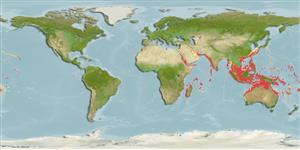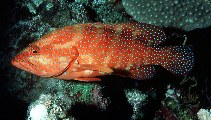Cephalopholis miniata (Forsskål, 1775)
Coral hind
Add your observation in Fish Watcher
| Native range | All suitable habitat | Point map | Year 2050 |

|
| This map was computer-generated and has not yet been reviewed. |
| Cephalopholis miniata AquaMaps Data sources: GBIF OBIS |
Upload your photos and videos
Pictures | Videos | Stamps, coins, misc. | Google imageCephalopholis miniata
Picture by Randall, J.E.
Pictures | Videos | Stamps, coins, misc. | Google imageCephalopholis miniata
Picture by Randall, J.E.
Saudi Arabia country information
Common names:
Hamoor, عجوز المرجان
Occurrence: native
Salinity: marine
Abundance: | Ref:
Importance: | Ref:
Aquaculture: | Ref:
Regulations: | Ref:
Uses: no uses
Comments: Also Ref. 4787. Museum: ZMUC P43567.
National Checklist:
Country Information: https://www.cia.gov/library/publications/resources/the-world-factbook/geos/sa.html
National Fisheries Authority:
Occurrences: Occurrences Point map
Main Ref: Heemstra, P.C. and J.E. Randall, 1993
National Database:
Occurrence: native
Salinity: marine
Abundance: | Ref:
Importance: | Ref:
Aquaculture: | Ref:
Regulations: | Ref:
Uses: no uses
Comments: Also Ref. 4787. Museum: ZMUC P43567.
National Checklist:
Country Information: https://www.cia.gov/library/publications/resources/the-world-factbook/geos/sa.html
National Fisheries Authority:
Occurrences: Occurrences Point map
Main Ref: Heemstra, P.C. and J.E. Randall, 1993
National Database:
Common names from other countries
Classification / Names Populärnamn | synonymer | Catalog of Fishes(Släkte, Arter) | ITIS | CoL | WoRMS | Cloffa
> Perciformes/Serranoidei (Groupers) > Epinephelidae (Groupers)
Etymology: Cephalopholis: Greek, kephale = head + Greek, pholis = scale (Ref. 45335).
More on author: Forsskål.
Etymology: Cephalopholis: Greek, kephale = head + Greek, pholis = scale (Ref. 45335).
More on author: Forsskål.
Environment: milieu / climate zone / depth range / distribution range Ekologi
marina revassocierade; ej vandrande; djupintervall 2 - 150 m (Ref. 9710). Tropical; 35°N - 32°S, 30°E - 156°W (Ref. 5222)
Utbredning Länder | FAO områden | Ekosystem | Förekomster | Point map | Utplanteringar | Faunafri
Indo-Pacific: Red Sea to Durban, South Africa and eastward to the Line Islands; including most islands in the Indian and west-central Pacific oceans. Absent from Persian Gulf and Gulf of Oman. Misidentified as Cephalopholis cyanostigma from Reunion (Ref. 6453).
Length at first maturity / Size / Vikt / Age
Short description Bestämningsnycklar | Morfologi | Morfometri
Taggstrålar i ryggfenan (totalt) : 9; Mjukstrålar i ryggfenan (totalt) : 14 - 15; Taggstrålar i analfenan: 3; Mjukstrålar i analfenan: 8 - 9. Color orange-red to reddish brown, usually dark posteriorly with numerous bright blue spots which are smaller than the pupil and often faintly dark-edged on head, body and median fins; distal margin of caudal fin and soft portions of dorsal and anal fins usually with a narrow blue margin and blackish submarginal line; orange-yellow pectoral fins, on some only distally; orange-red pelvic fins; it is capable of a disruptive color pattern of irregular oblique olivaceous bars; juveniles may be yellow with scattered faint blue spots. D IX, 14-16; A III, 8-9 (rarely 8); pectoral 17-18 (often 18); scales on lateral line 47-55; scales on longitudinal series 94-114; snout anterior to nostrils no scales; partially scaled maxilla; abdomen with cycloid scales; gill rakers 7-9 + 13-15; depth of body 2.65-3.05 in SL; length of head 2.4-2.65 in SL; the maxilla extends to or posterior to rear of the orbit; smooth ventral margin of preopercle; 5th - 8th dorsal spines longest , 3.0-3.6 in head; pectoral fins 1.45-1.75 in head; pelvic fins do not reach the anus, 1.9-2.3 in head (Ref. 4787).
Inhabit clear waters of coral reefs; more often found in exposed rather than protected reef areas (Ref. 5213). Feed on fishes (80%, mainly Pseudanthias squamipinnis) and crustaceans. Form haremic groups comprising of a dominant male and 2 to 12 females. These groups occupy territories of up to 475 sq m subdivided into secondary territories and defended by a single female (Ref. 6480). Generally common (Ref. 9710).
Life cycle and mating behavior Könsmognad | Reproduktion | Lek | Ägg | Fecundity | Larver
Main reference
Upload your references | referenser | Koordinator | Medarbetare
Heemstra, P.C. and J.E. Randall, 1993. FAO Species Catalogue. Vol. 16. Groupers of the world (family Serranidae, subfamily Epinephelinae). An annotated and illustrated catalogue of the grouper, rockcod, hind, coral grouper and lyretail species known to date. Rome: FAO. FAO Fish. Synop. 125(16):382 p. (Ref. 5222)
IUCN Red List Status (Ref. 130435: Version 2024-2)
Least Concern (LC) ; Date assessed: 12 November 2017
Threat to humans
Harmless
Human uses
Fiskeri: kommersiell; sportfisk: ja; Akvarium: Kommersiell
FAO(fiskeri: produktion; publication : search) | FishSource | Sea Around Us
Ytterligare information
Population dynamics
Tillväxtparametrar
Max. ages / sizes
Length-weight rel.
Length-length rel.
Length-frequencies
Mass conversion
Rekrytering
Abundans
Tillväxtparametrar
Max. ages / sizes
Length-weight rel.
Length-length rel.
Length-frequencies
Mass conversion
Rekrytering
Abundans
Life cycle
Reproduktion
Könsmognad
Fecundity
Lek
Spawning aggregations
Ägg
Egg development
Larver
Larvdynamik
Reproduktion
Könsmognad
Fecundity
Lek
Spawning aggregations
Ägg
Egg development
Larver
Larvdynamik
Physiology
Body composition
Nutrients
Syreförbrukning
Swimming type
Simhastighet
Visual pigments
Fish sound
Diseases & Parasites
Toxicity (LC50s)
Body composition
Nutrients
Syreförbrukning
Swimming type
Simhastighet
Visual pigments
Fish sound
Diseases & Parasites
Toxicity (LC50s)
Genetics
Genetik
Heterozygosity
Ärftlighet
Genetik
Heterozygosity
Ärftlighet
Human related
Aquaculture systems
Vattenbruksprofiler
Avelslinjer
Ciguatera cases
Stamps, coins, misc.
Aquaculture systems
Vattenbruksprofiler
Avelslinjer
Ciguatera cases
Stamps, coins, misc.
Verktyg
Bio-Quiz | E-book | Fälthandbok | Bestämningsnycklar | Längdfördelnings-verktyg | Livshistorie-verktyg | Prickkarta | Classification Tree
| Catch-MSY |
Special reports
Download XML
Internet-källor
Aquatic Commons | BHL | Cloffa | BOLDSystems | Websites from users | Check FishWatcher | CISTI | Catalog of Fishes(Släkte, Arter) | DiscoverLife | DORIS | ECOTOX | Faunafri | Fishtrace | GenBank(genome, nucleotide) | GloBI | GOBASE | | Google Books | Google Scholar | Google | IGFA World Record | MitoFish | Nationella databaser | Otolith Atlas of Taiwan Fishes | Offentliga akvarier | PubMed | Reef Life Survey | Scirus | SeaLifeBase | Tree of Life | Wikipedia(Go, sök) | World Records Freshwater Fishing | Zoological Record
Estimates based on models
Preferred temperature (Ref. 115969): 23.7 - 29, mean 27.8 (based on 2104 cells).
Phylogenetic diversity index (Ref. 82804): PD50 = 0.5000 [Uniqueness, from 0.5 = low to 2.0 = high].
Bayesian length-weight: a=0.01072 (0.00714 - 0.01608), b=3.06 (2.94 - 3.18), in cm Total Length, based on LWR estimates for this species & Genus-body shape (Ref. 93245).
Trofisk nivå (Ref. 69278): 4.3 ±0.5 se; based on diet studies.
Resiliens (Ref. 120179): Låg, lägsta populationsfördubblingstid 4,5-14 år (tmax=30; K=0.101).
Fishing Vulnerability (Ref. 59153): High to very high vulnerability (65 of 100).
Climate Vulnerability (Ref. 125649): High vulnerability (57 of 100).




